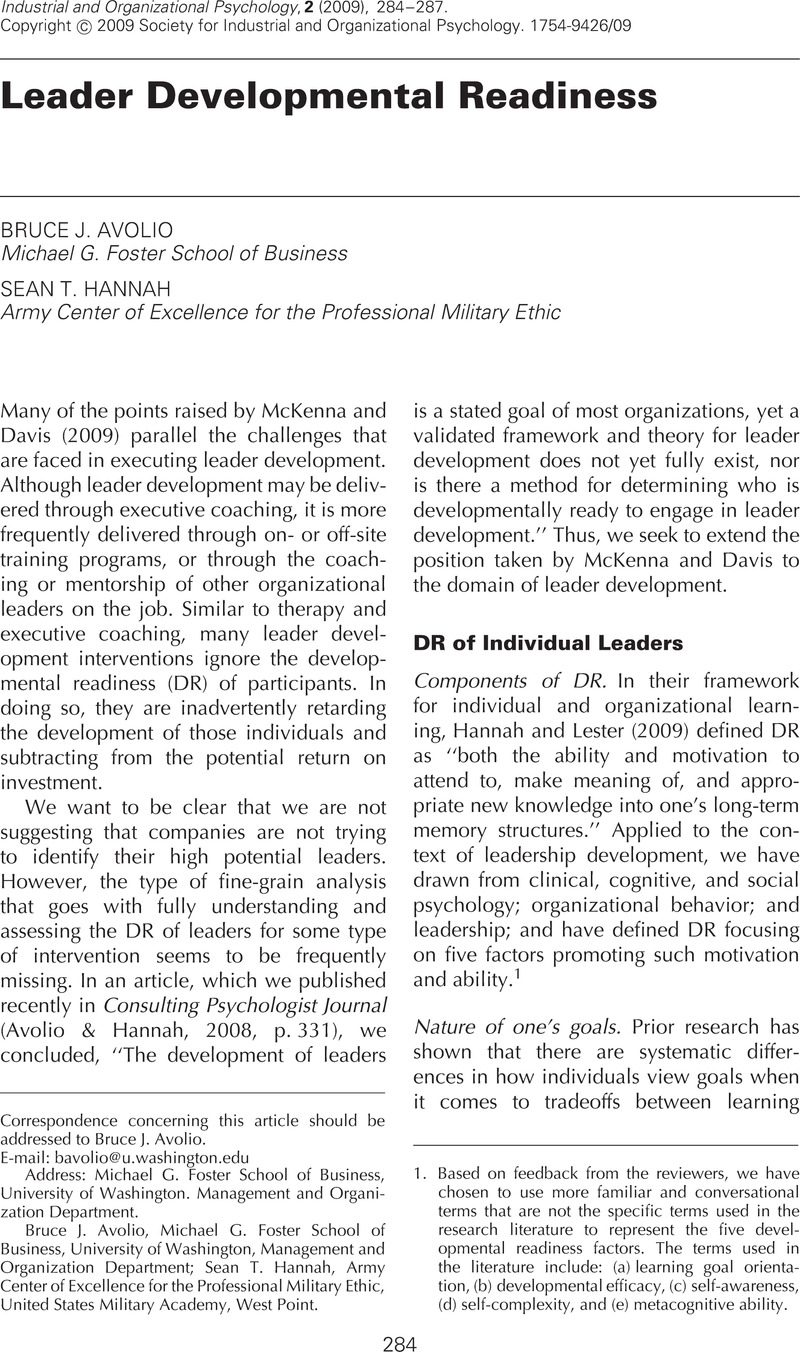Crossref Citations
This article has been cited by the following publications. This list is generated based on data provided by Crossref.
McKenna, D. Douglas
and
Davis, Sandra L.
2009.
What Is the Active Ingredients Equation for Success in Executive Coaching?.
Industrial and Organizational Psychology,
Vol. 2,
Issue. 3,
p.
297.
Tesluk, Paul
and
Kudisch, Jeffrey
2010.
Advancing Executive Coaching.
p.
431.
Acharya, Guru
2010.
A Mathematical Model of Organisational Leadership.
SSRN Electronic Journal,
Harms, P.D.
Spain, Seth M.
and
Hannah, Sean T.
2011.
Leader development and the dark side of personality.
The Leadership Quarterly,
Vol. 22,
Issue. 3,
p.
495.
A. Blair, Carrie
Allen Gorman, Charles
Helland, Katherine
and
Delise, Lisa
2014.
The smart leader: examining the relationship between intelligence and leader development behavior.
Leadership & Organization Development Journal,
Vol. 35,
Issue. 3,
p.
241.
Ladegard, Gro
and
Gjerde, Susann
2014.
Leadership coaching, leader role-efficacy, and trust in subordinates. A mixed methods study assessing leadership coaching as a leadership development tool.
The Leadership Quarterly,
Vol. 25,
Issue. 4,
p.
631.
Ren, Shuang
Collins, Ngan
and
Zhu, Ying
2014.
Leadership self-development in China and Vietnam.
Asia Pacific Journal of Human Resources,
Vol. 52,
Issue. 1,
p.
42.
Murphy, Susan Elaine
and
Johnson, Stefanie K.
2016.
Leadership and Leader Developmental Self‐Efficacy: Their Role in Enhancing Leader Development Efforts.
New Directions for Student Leadership,
Vol. 2016,
Issue. 149,
p.
73.
Reichard, Rebecca J.
and
Walker, Dayna O.
2016.
In Pursuit: Mastering Leadership Through Leader Developmental Readiness.
New Directions for Student Leadership,
Vol. 2016,
Issue. 149,
p.
15.
Avolio, Bruce J.
2016.
Introduction: The Golden Triangle for Examining Leadership Developmental Readiness.
New Directions for Student Leadership,
Vol. 2016,
Issue. 149,
p.
7.
Kasemsap, Kijpokin
2016.
Managerial Strategies and Practice in the Asian Business Sector.
p.
238.
Rosch, David M.
and
Villanueva, Josh C.
2016.
Motivation to Develop as a Leader.
New Directions for Student Leadership,
Vol. 2016,
Issue. 149,
p.
49.
Kasemsap, Kijpokin
2016.
Project Management.
p.
178.
Thompson, Sara E.
and
Reichard, Rebecca J.
2016.
Context Matters: Support for Leader Developmental Readiness.
New Directions for Student Leadership,
Vol. 2016,
Issue. 149,
p.
97.
Reichard, Rebecca J.
Walker, Dayna O.
Putter, Stefanie E.
Middleton, Eric
and
Johnson, Stefanie K.
2017.
Believing Is Becoming.
Journal of Leadership & Organizational Studies,
Vol. 24,
Issue. 2,
p.
137.
Tuncdogan, Aybars
Acar, Oguz Ali
and
Stam, Daan
2017.
Individual differences as antecedents of leader behavior: Towards an understanding of multi-level outcomes.
The Leadership Quarterly,
Vol. 28,
Issue. 1,
p.
40.
Rothausen, Teresa J.
2017.
Integrating Leadership Development with Ignatian Spirituality: A Model for Designing a Spiritual Leader Development Practice.
Journal of Business Ethics,
Vol. 145,
Issue. 4,
p.
811.
Zaccaro, Stephen J.
Green, Jennifer P.
Dubrow, Samantha
and
Kolze, MaryJo
2018.
Leader individual differences, situational parameters, and leadership outcomes: A comprehensive review and integration.
The Leadership Quarterly,
Vol. 29,
Issue. 1,
p.
2.
Saxena, Anurag
Desanghere, Loni
and
Suryavanshi, Palak
2018.
Developmental readiness and leadership development in medicine.
BMJ Leader,
Vol. 2,
Issue. 2,
p.
71.
Pitichat, Thiraput
Reichard, Rebecca J.
Kea-Edwards, Amber
Middleton, Eric
and
Norman, Steven M.
2018.
Psychological Capital for Leader Development.
Journal of Leadership & Organizational Studies,
Vol. 25,
Issue. 1,
p.
47.



